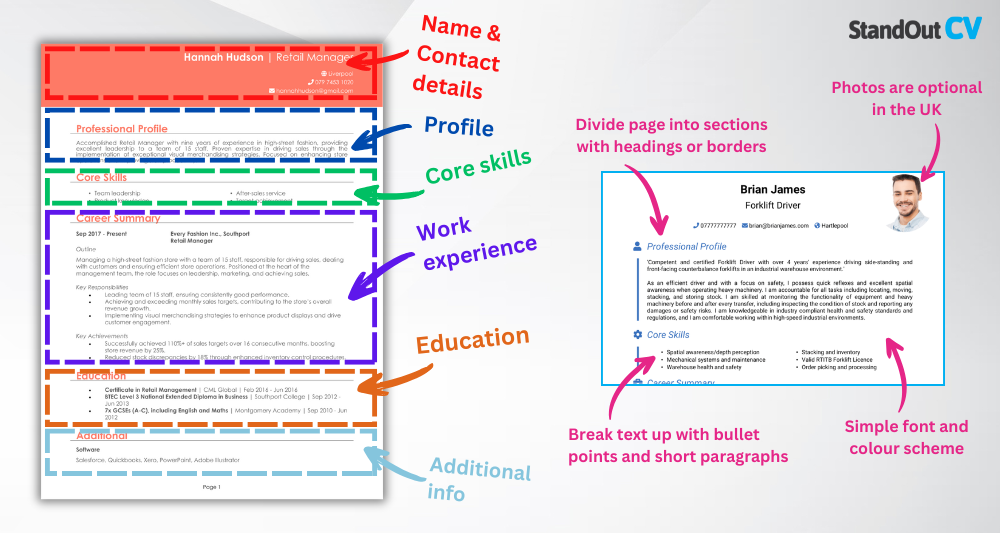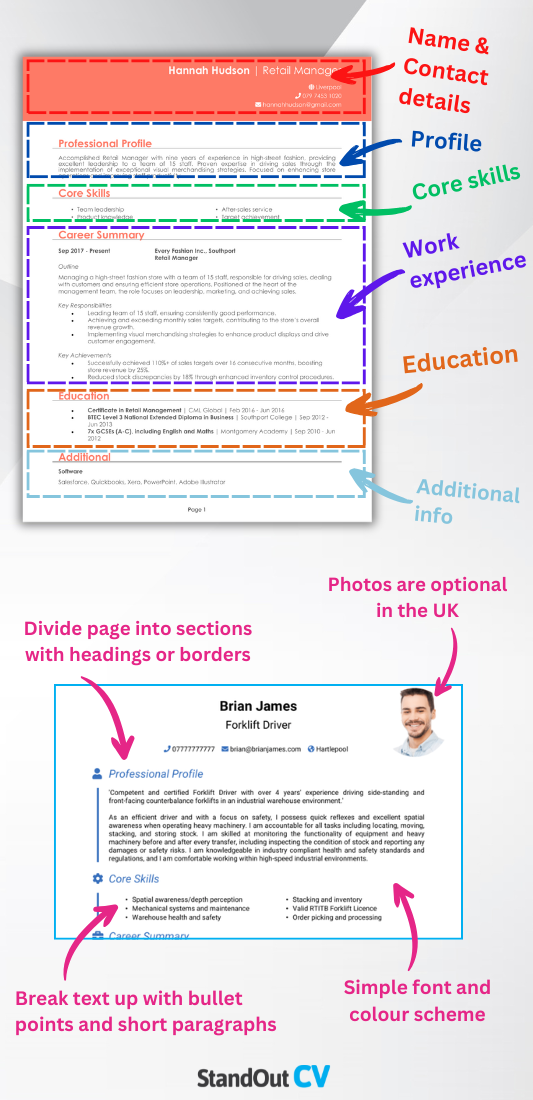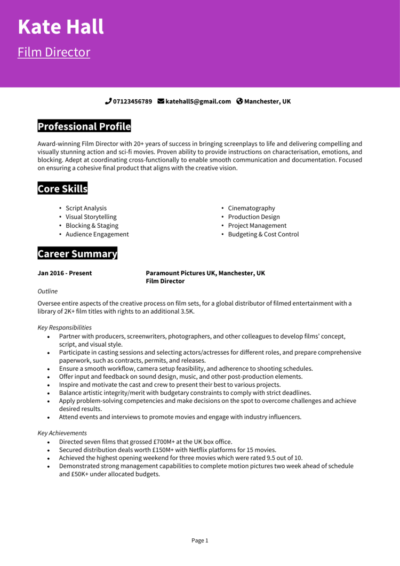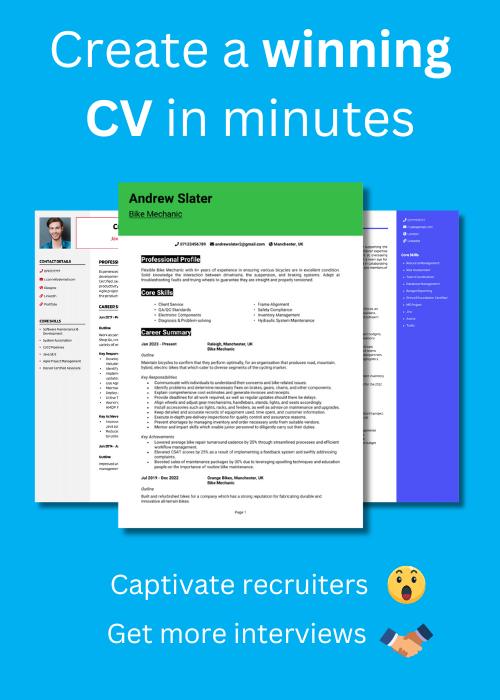You’ve mastered the art of telling other people’s stories – but now it’s time to shape your own. Your CV isn’t just a list of credits; it’s a pitch to show why you’re the right person to bring a vision to life.
Whether you work in film or TV, this guide and its Film Director CV example will help you write a professional CV that communicates your creative identity and your ability to lead a production from storyboard to final cut.
Film Director CV sample

How to write your Film Director CV
Discover how to craft a winning Film Director CV that lands interviews with this simple step-by-step guide.
Film is all about perspective – and your CV should reflect yours. This isn’t just about listing jobs or awards; it’s about creating a compelling narrative that tells a recruiter or producer exactly what kind of storyteller you are.
This guide walks you through writing a CV, showing you how to align layout and content with your experience and goals as a film director.
What’s the right way to structure and format your Film Director CV?


A film set thrives on clarity. Your CV should serve the same purpose: making your skills, experience, and style immediately clear to whoever’s reading it. Whether it’s a studio exec, a commissioning producer, or a creative agency director, they need to scan your document and quickly understand what you bring to the table – without needing a second take.
Here’s the layout to follow:
- Name and contact details – Place your name and personal details prominently at the top of your CV for quick access. Adding a photo is up to you.
- Profile – Open with a compelling overview of your skills, experience, and career goals.
- Core skills – List your key abilities in this section, focusing on those that will be most relevant to the job.
- Work experience – Provide a detailed breakdown of your work history, starting with the most recent job first.
- Education – List your qualifications, including degrees and relevant certifications, in reverse chronological order.
- Additional info – Use this optional space for relevant hobbies or personal pursuits that enhance your application.
Use bullet points to make the document easy to scan. Choose a clean, professional font and use clear section headings to create flow. Two pages is your ideal length limit – enough to show range without losing focus. Prioritise structure and readability across your CV’s format, even if your directing style leans experimental – clarity wins auditions here!
How to create a Film Director CV profile


This short paragraph sits at the top of your CV and sets the tone for everything that follows. It should reflect your creative approach and track record of bringing projects to life – not just visually, but logistically and collaboratively.
More than a highlight reel, your CV profile is your chance to show what you bring to a set and how your direction contributes to the overall production.
Film Director CV profile examples
Profile 1
Experienced Film Director with over 12 years leading award-winning feature films, documentaries, and short-form digital content. Skilled in visual storytelling, script development, and directing talent across diverse genres. Strong creative vision combined with a hands-on approach to production planning, budgeting, and post-production workflows.
Profile 2
Creative Film Director with eight years of experience directing narrative films and branded content for global streaming platforms and independent studios. Adept at collaborating with writers, producers, and cinematographers to realise compelling stories on screen. Proficient in Adobe Premiere Pro, DaVinci Resolve, and on-set leadership.
Profile 3
Visionary Film Director with five years’ experience in festival-circuit short films, music videos, and indie features. Strong ability to shape narrative tone and performance while overseeing pre-production, location scouting, and editing. Committed to authentic representation and emotionally resonant storytelling.
Details to put in your Film Director CV profile
Here are some tips on what to include:
- Where you worked – Mention the studios, networks, or production houses you’ve directed for, including the types of projects.
- Your top qualifications – Note any formal training in directing, screen production, or film studies.
- Essential skills – Briefly outline your strengths in visual storytelling, crew leadership, and production oversight.
- Genres or formats – Refer to the mediums you’ve directed in – short film, feature, TV drama, documentary, etc.
- Value delivered – Highlight the creative impact of your direction: festival wins, strong reviews, audience engagement, or successful project delivery.
Presenting your core skills


In the core CV skills section, focus on your ability to lead a production creatively and logistically. This is your chance to outline your high-level competencies – not in vague terms, but in clear alignment with the needs of a production company or commissioner.
Keep it specific to the kind of directing work you’re applying for. This section should reflect tangible abilities, from collaborating with cinematographers to working within tight budgets and schedules. Tailor it carefully, using the job spec as a guide: those are the keywords recruiters are looking for.
Essential skills that recruiters look for in a Film Director CV
- Script Analysis and Visual Interpretation – Breaking down scripts to develop a compelling visual narrative, tone, and pacing for the film.
- Creative Direction and Storytelling – Shaping the artistic vision of a film, guiding performances, camera work, and overall narrative flow.
- Casting and Talent Collaboration – Selecting actors and working closely with them to develop characters and deliver strong performances.
- Shot Planning and Storyboarding – Designing shot sequences and storyboards in collaboration with cinematographers and production designers.
- On-Set Leadership and Decision-Making – Directing cast and crew during filming, making real-time creative and technical decisions.
- Collaboration with Department Heads – Coordinating with producers, editors, art directors, and sound designers to align vision across departments.
- Post-Production Oversight – Supervising editing, colour grading, sound design, and visual effects to ensure the final cut reflects the intended vision.
- Budget and Schedule Management – Working with production teams to deliver projects on time and within budget without compromising artistic goals.
- Audience and Genre Awareness – Tailoring creative choices to fit the intended audience, platform, and genre conventions.
- Festival and Distribution Strategy – Supporting the positioning of the film for festival circuits, awards consideration, and commercial release.
How to highlight work experience


Your work experience should tell a story just as well as your films do. Each project should show how you took a vision and turned it into something real – not just directing performances, but shaping the tone and delivering a cohesive end product.
Walk the reader through your projects or jobs in reverse chronological order. For each one, write a brief paragraph to set the context – name the production, the company, your role, and its scale or format. Then use bullet points to outline key contributions and achievements, such as creative decisions, shoot coordination, budget management, and audience or critical response.
How to make your past experience easy to read for employers

- Outline – Name the production, client, or studio, and clarify whether it was a short film, feature, series, or other. Include your role and the scope of the project.
- Responsibilities – Use action words like “directed” and “guided.” For example: “directed a 12-episode web series for a youth-focused streaming platform” or “guided actors through scene work and improvisational workshops.”
- Achievements – Focus on outcomes. Did the production premiere at a notable festival? Was it picked up by a distributor? Use tangible results – audience numbers, awards, reviews – to show the success of your direction.
Example job entries for Film Directors
Film Director | Arcadia Pictures
Outline
Directed multiple short films and a feature-length psychological drama for an independent production company with international distribution partners.
Responsibilities
- Oversaw all creative aspects of film production from script revisions to final cut
- Directed actors and crew on set, ensuring creative consistency across scenes
- Collaborated with DOP and production designer to define visual tone
- Worked with post-production team to edit, colour grade, and score the film
- Submitted final versions to festivals and coordinated with PR for promotion
Achievements
- Feature film shortlisted at Tribeca and won Best Director at Edinburgh Film Awards
- Completed production within 10% of budget across all projects
- Secured development funding from national arts council for next feature
Film Director | Level North Studios
Outline
Directed music videos and branded content for commercial clients and record labels at a boutique creative studio.
Responsibilities
- Conceptualised and pitched treatments based on client briefs and brand identity
- Directed on-location and studio shoots, managing cast and technical crew
- Worked closely with producers to develop feasible shooting schedules
- Supervised post-production workflow including VFX and sound design
- Managed creative revisions in collaboration with agency and clients
Achievements
- Directed five music videos with over 2M combined YouTube views
- Delivered branded campaign that won regional advertising award
- Achieved 100% client satisfaction rate across 12 consecutive projects
Film Director | Freelance Projects
Outline
Directed independent short films and micro-budget productions selected for national and international festivals.
Responsibilities
- Wrote and directed narrative scripts with limited crew and resources
- Recruited talent and locations, managed all pre-production logistics
- Led rehearsals and directed performances on set
- Handled editing and colour correction using Adobe Premiere Pro
- Created EPKs and submitted films to festivals and streaming platforms
Achievements
- Winner of Best Short Film at Leeds International Film Festival
- Shortlisted for a BAFTA-qualifying student film competition
- Built online following through successful crowdfunding and festival screenings
Education and qualifications


While experience is often king in the film industry, a relevant qualification can help show your formal grounding in media production. This section should clearly list your academic background, including any degrees, film school training, or industry-certified workshops.
There’s no need to go deep into every module – just outline your main education credentials, especially if they’re tied to directing, editing, production management, or screenwriting. If you’ve done a residency or mentorship programme, include that too.
Qualifications recruiters look for in a Film Director
- BA or MA in Film Production or Directing – Offers strong academic grounding in directing and visual storytelling
- NFTS Directing Diploma – Prestigious UK-based qualification for emerging directors
- Raindance or BFI Film Academy programmes – Recognised practical workshops and training initiatives
- ScreenSkills-certified directing courses – Offers industry-respected credentials for film and TV professionals
- Degree in Theatre, Media, or Visual Arts – Helpful if paired with directing experience or production training





